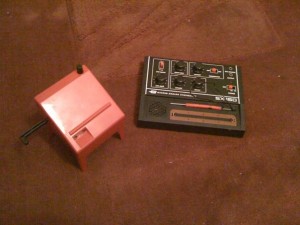As an Interactive Audio Designer, I explore world of sound in many different ways. On Thursday afternoon I got a text message from my girlfriend saying that a package had arrived for me from Japan. I had recently purchased two hobby kits. A Gakken Mini Theremin and Gakken SX-150 Analog Synthesizer. That night, before I went to bed I finished building both kits.
A Theremin is a truly amazing musical instrument that is played without touching it. It’s most commonly associated with old Sci-Fi movie sound effects and the “oooweeeeoooo” sound in the Beach Boys’ hit song, “Good Vibrations.” When I was working on the Destroy All Humans video game franchise, we incorporated the sound of the theremin into the movement of the UFO.
According to Wikipedia,
The theremin was originally the product of Russian government-sponsored research into proximity sensors. The instrument was invented by a young Russian physicist named Lev Sergeivich Termen (known in the West as Léon Theremin) in October 1920[2] after the outbreak of the Russian civil war. After positive reviews at Moscow electronics conferences, Theremin demonstrated the device to Bolshevik leader Vladimir Lenin. Lenin was so impressed with the device that he began taking lessons in playing it,[3] commissioned six hundred of the instruments for distribution throughout the Soviet Union, and sent Theremin on a trip around the world to demonstrate the latest Soviet technology and the invention of electronic music. After a lengthy tour of Europe, during which time he demonstrated his invention to packed houses, Theremin found his way to the United States, where he patented his invention in 1928 (US1661058). Subsequently, Theremin granted commercial production rights to RCA.
Analog Synthesizers are also very cool. While the theremin is a type of analog synthesizer, the SX-150 offers greater control over the effecting and processing of it’s noise source. It includes a low-pass filter, resonance, attack, decay and both square and sawtooth noise generation. An 1/8 inch external input and output are also built in although I had a bit of trouble with getting the input to function correctly as did a few others who built the same kit.
Both kits were very simple to build. No soldering was required. The directions were all in Japanese, but there were detailed illustrations that made it so that anyone familiar with following instructions from a Lego set could construct one of these. Assembly required a very small phillips head screwdriver and 4 AA batteries each.
Both kits may be purchased from the Maker Shed.
Mini Theremin – $29.99 + S/H
SX-150 Analog Synthesizer Kit – $54.99
